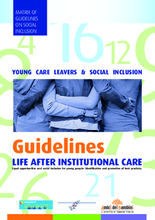Who are we talking about? Care leavers are generally recognised as people leaving the social protection system.
We focus on young people without a stable family who are leaving or have recently left alternative care or residential placements (where they have grown up) after reaching majority or a legally set age (usually, 18 yrs old).
The risk of social exclusion they are subject to increases significantly in the presence of the following variables:
• long-term permanence in the welfare alternative or residential care system
• stay in residential placements (not in a family environment)
• early inclusion in an institution.
What are we talking about?
The institutionalisation of children (or their placement in a residential structure) in answer to situations of family discomfort, on a more or less temporary basis, is still a popular solution adopted by European protection systems, notwithstanding the focus of all social policies on family support.
Thus, given the variables connected to the number of people in residential structures and the average age of such people, between 14 and 17 years of age, it is not diffi cult to conclude that the issue of social exclusion shall have to be tackled by the member states also in the long term. The data emerging from the transnational research which is at the basis of these guidelines show that in the next few years the number of care leavers shall rise to about 10,200 in Italy, 5,500 in Bulgaria, more than 8,800 in Romania. Between 2004 and 2006 there were more than 4,800 care leavers who asked for the social inclusion subsidy in Latvia, while in 2006 in France more than 55,000 young people lived in residential structures, 15% of whom were between 18 and 21 years of age.
How have we proceeded?
In the 5 countries involved, the central project and scientific team collected the data that were necessary to build the matrix.
1. Desk Analysis: relevant legislation, context and specific data (if any), services organisation and list of players;
2. Qualitative analysis:
a. giving out of 75 in-depth questionnaires (15 for each country) to the main actors in the social protection system, starting from those farthest from the subjects and proceeding inwards to the people most involved in the case (i.e., from the central decision makers, to the national coordinators, to the local decision makers, to the institution and education community managers, to the social workers and fi nally to the educators);
b. giving out of 125 in-depth questionnaires (25 for each country) to young people who have been out of the child protection system for at least two years, but for no longer than 5, and young people in the transition phase to adult life (recipients of specifi c social inclusion programmes).
3. Exchange and discussion activities with stakeholders and operators.
What do we suggest?
Below we have included a matrix of guidelines which, if applied, should increase the likelihood of social inclusion for young people who have been released from the child protection system. The guidelines shown in the matrix have been developed in the course of the project, but they are considered valid on a cross sectional basis throughout Europe.

